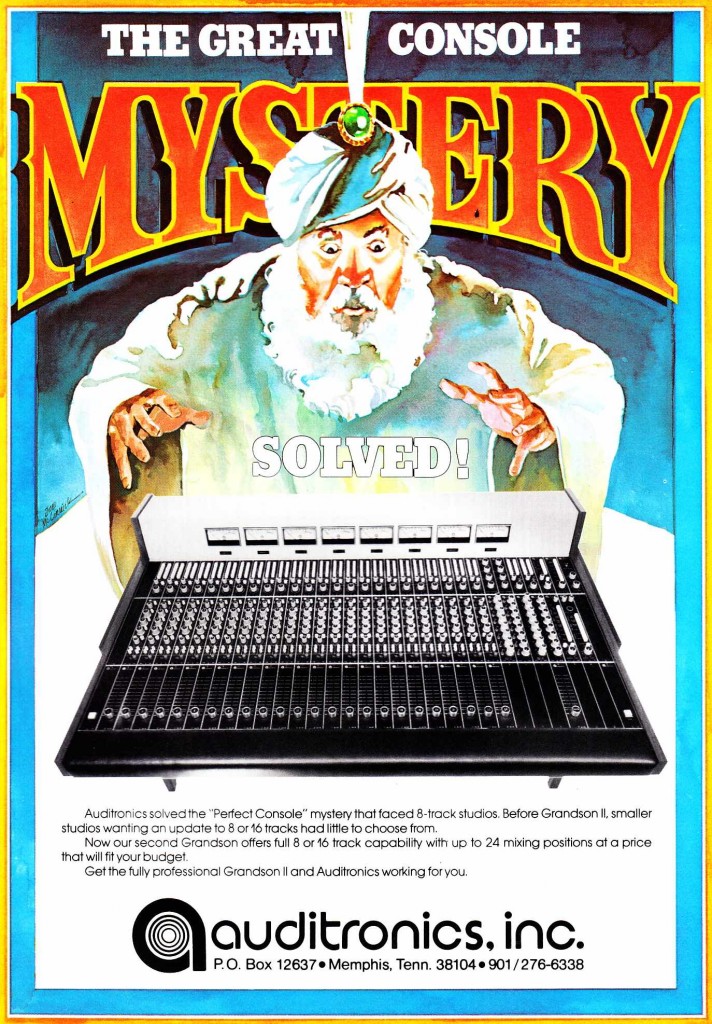 Above: the Audiotronics Grandson II console circa 1975
Above: the Audiotronics Grandson II console circa 1975
Way back in October of 2010 I ran a short piece about some 1970s audio consoles, and now 70s month rolls on with an extensive image gallery of some iconic and some obscure mixing desks from that decade. I’m a hardware mixer fan; I learned audio production in a studio with a Trident Trimix and my brain often just defaults to finding solutions and working-methods that are faster to do with a real console rather than via a DAW. I would never give up my Pro Tools, no way… but I honestly can’t imagine giving up the flexibility and endless options that a good-sounding, full-featured console offers. At Gold Coast Recorders, our Wheatstone SP6 has been going strong for two years now; I’ve had to replace the control room section due to a weird intermittent issue, but I since I had planned ahead and bought a spares-board it was pretty painless. If you look past the real fetish-brands like API and Neve (great stuff, no doubt) there are a million bargains to be had if you are able to do a little tech work (or pay a decent technician). I bought both of my SP6s for about $1500, TOTAL, with shipping, and put about 60 hours into arriving at a single great-functioning piece, fully cabled to my patchbays, and with a lifetime worth of spares. Considering that these SP6s cost around $40,000 each in the mid nineties, this is a pretty great deal. I guess I’d sum it up this way: if you record bands, if you have the physical room for a console, if you have the patience and/or where-with-all to do some basic troubleshooting, and the board is modular (very important….), I feel like you really can’t go wrong. Given the outrageous prices of vintage outboard gear on the market today, vintage consoles represent an amazing bargain. And a potentially amazing headache. So be careful.
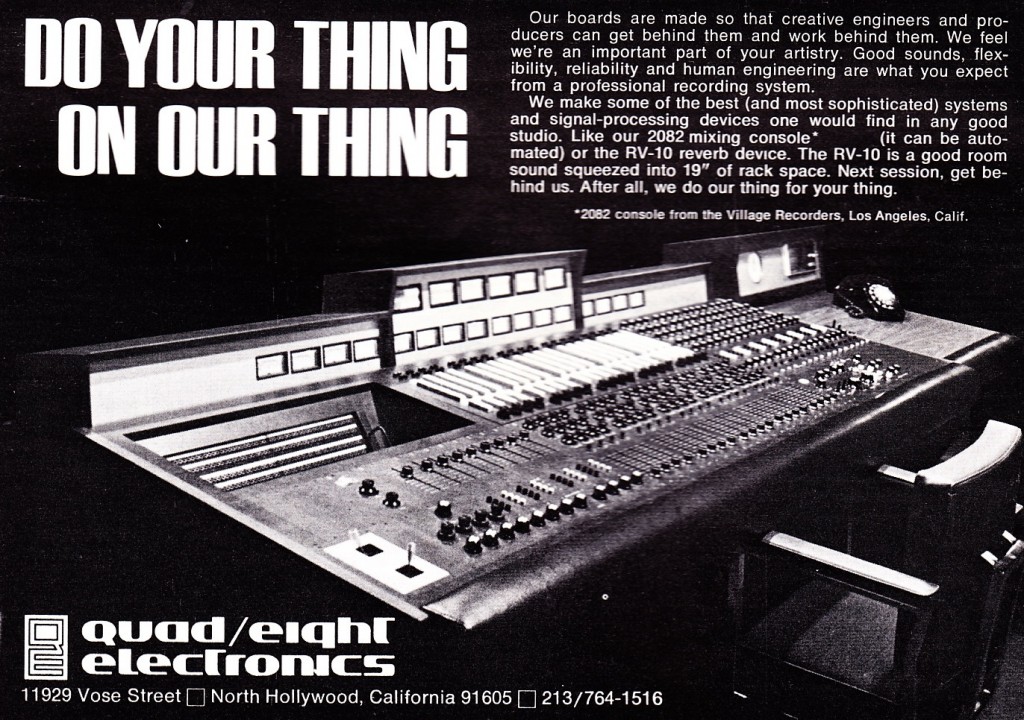 Above: Quad/eight 2082 console circa 1972
Above: Quad/eight 2082 console circa 1972
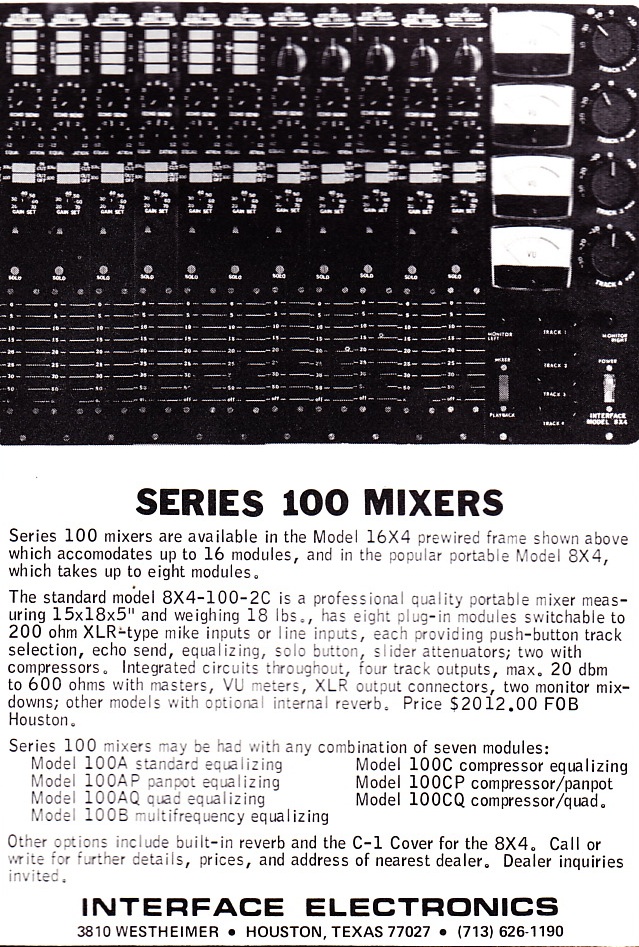 Above: Interface Electronics Series 100 console circa 1973
Above: Interface Electronics Series 100 console circa 1973
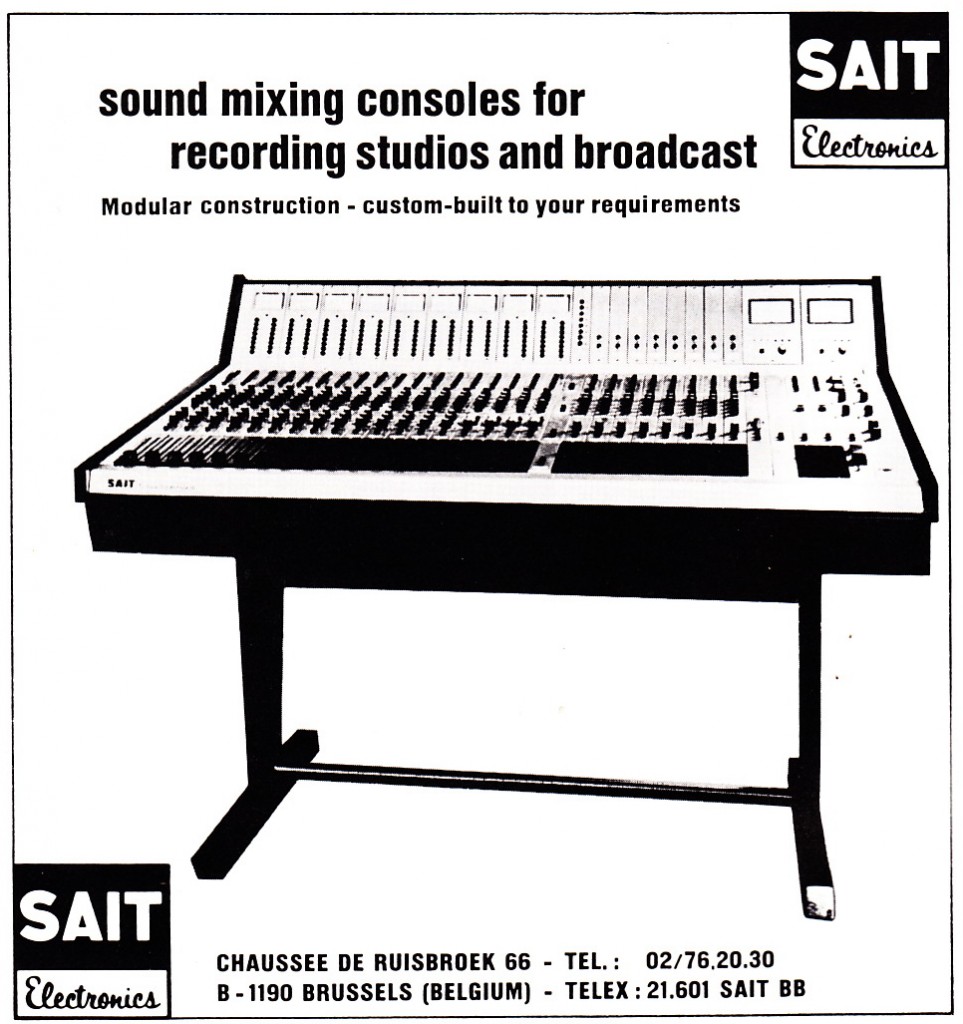 Above: Sait, a Belgium maker, offered this board in ’73
Above: Sait, a Belgium maker, offered this board in ’73
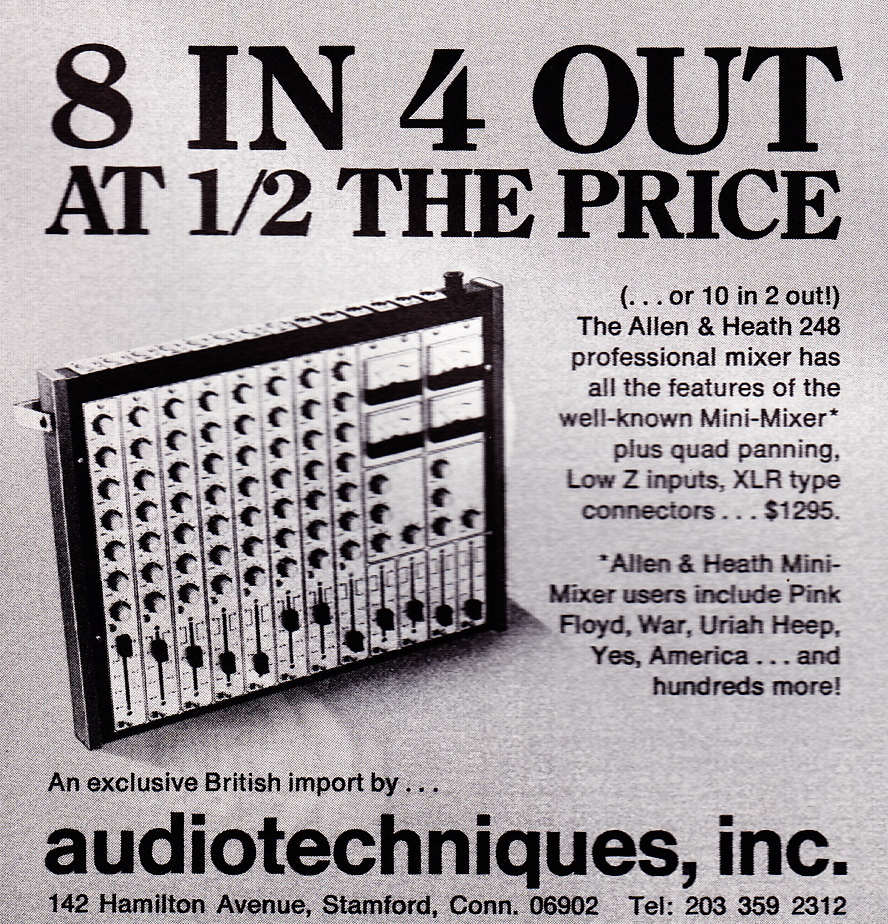 The Allen+Heath 248 portable mixer circa 1973
The Allen+Heath 248 portable mixer circa 1973
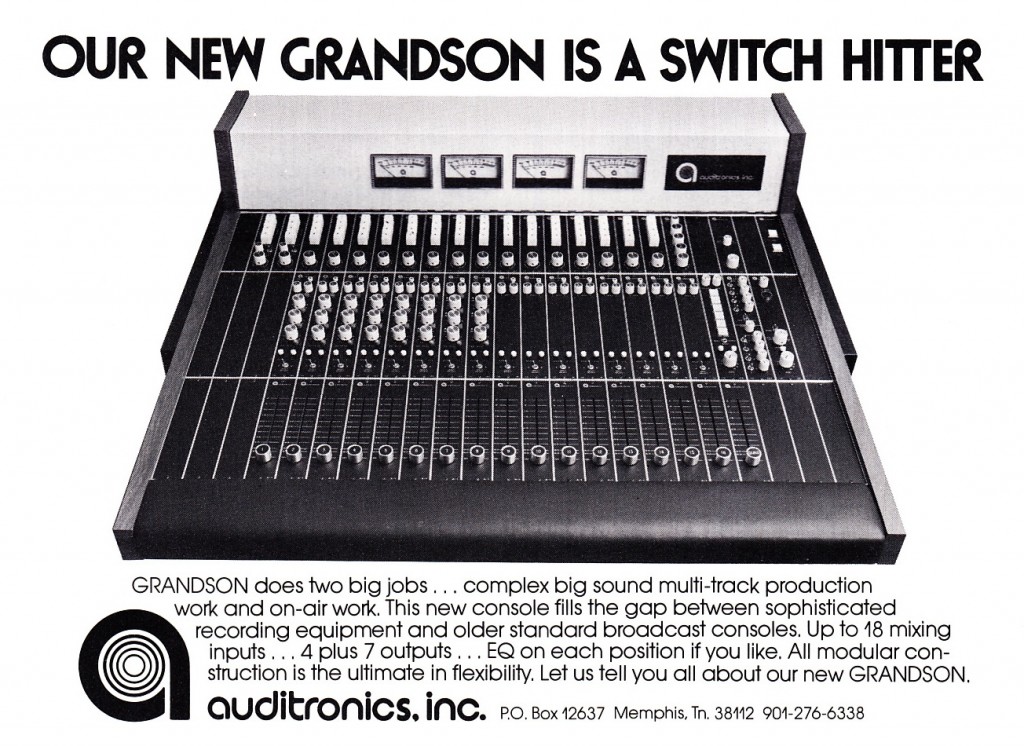 The earlier iteration of the Audiotronics Grandson, this one from 1973
The earlier iteration of the Audiotronics Grandson, this one from 1973
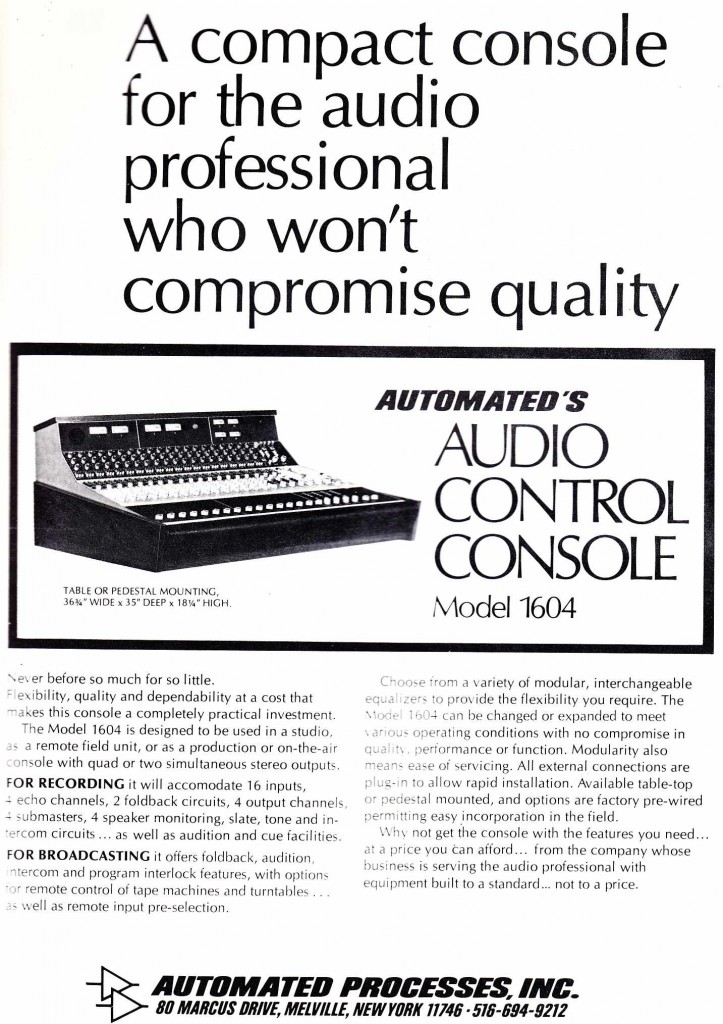 The API 1604 as-seen in 1974, and as still-seen in studios worldwide
The API 1604 as-seen in 1974, and as still-seen in studios worldwide
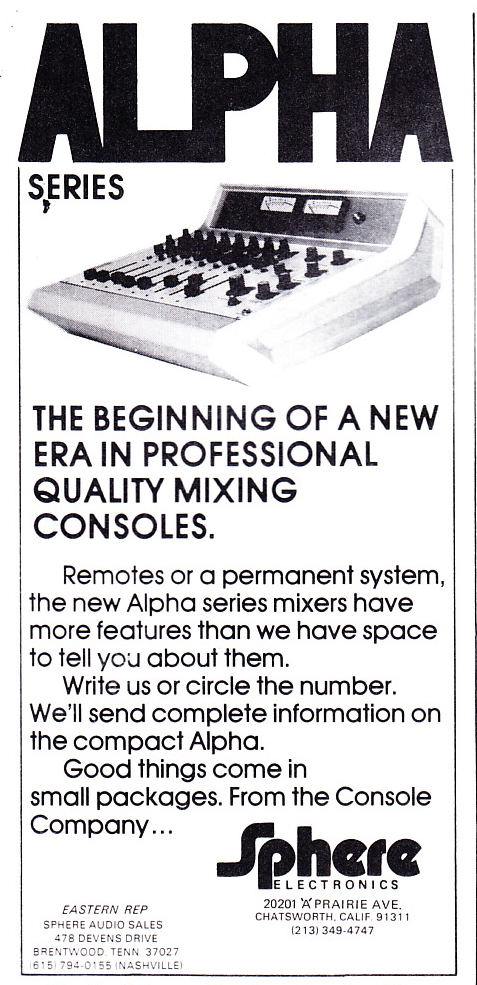 Sphere was a high-end console-maker that I know almost nothing about; here we see their ALPHA, a compact model from 1975
Sphere was a high-end console-maker that I know almost nothing about; here we see their ALPHA, a compact model from 1975
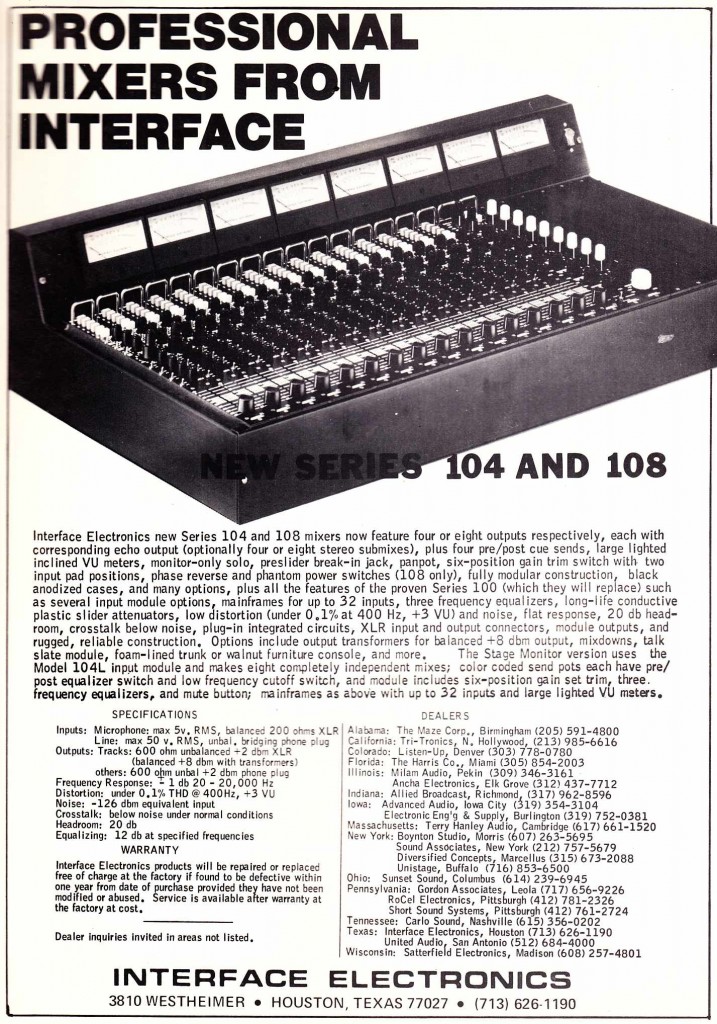 In 1976 Interface offered the 104 and 108 series consoles
In 1976 Interface offered the 104 and 108 series consoles
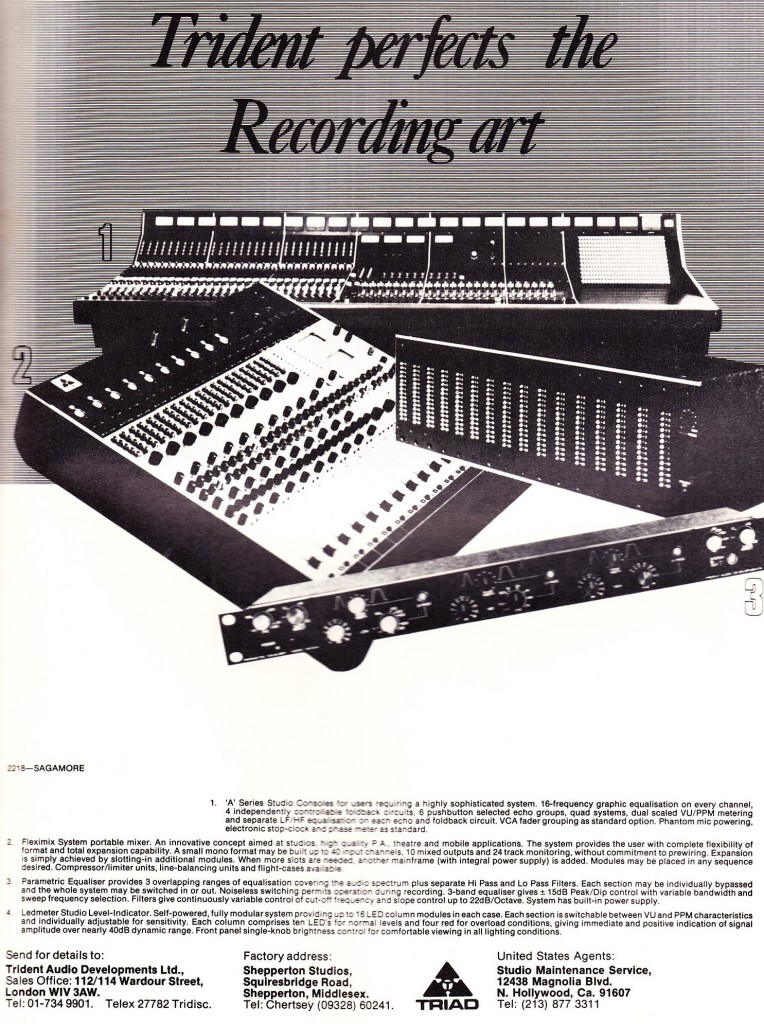 Above: the Trident range circa ’77. Apologies for the poor scan, I think I may need to invest in a new scanner. As I mentioned at the head, I learned on the Trident Trimix, which was a ‘portable’ unit (portable but still around 150lbs!) that was offered a bit later. I later learned the dark side of the Trimix is that… aside from the mic inputs, none of it is balanced and the signal-to-noise ratio is very poor. Which brings up a good point: before investing in one of these things, research the specs. What I hadn’t known then is that the Trimix was originally conceived of as a live console… designed especially for Queen, if I recall correctly…Anyhow, yes the EQ sounded amazing and the build quality was high but it was far too noisy for modern productions.
Above: the Trident range circa ’77. Apologies for the poor scan, I think I may need to invest in a new scanner. As I mentioned at the head, I learned on the Trident Trimix, which was a ‘portable’ unit (portable but still around 150lbs!) that was offered a bit later. I later learned the dark side of the Trimix is that… aside from the mic inputs, none of it is balanced and the signal-to-noise ratio is very poor. Which brings up a good point: before investing in one of these things, research the specs. What I hadn’t known then is that the Trimix was originally conceived of as a live console… designed especially for Queen, if I recall correctly…Anyhow, yes the EQ sounded amazing and the build quality was high but it was far too noisy for modern productions.
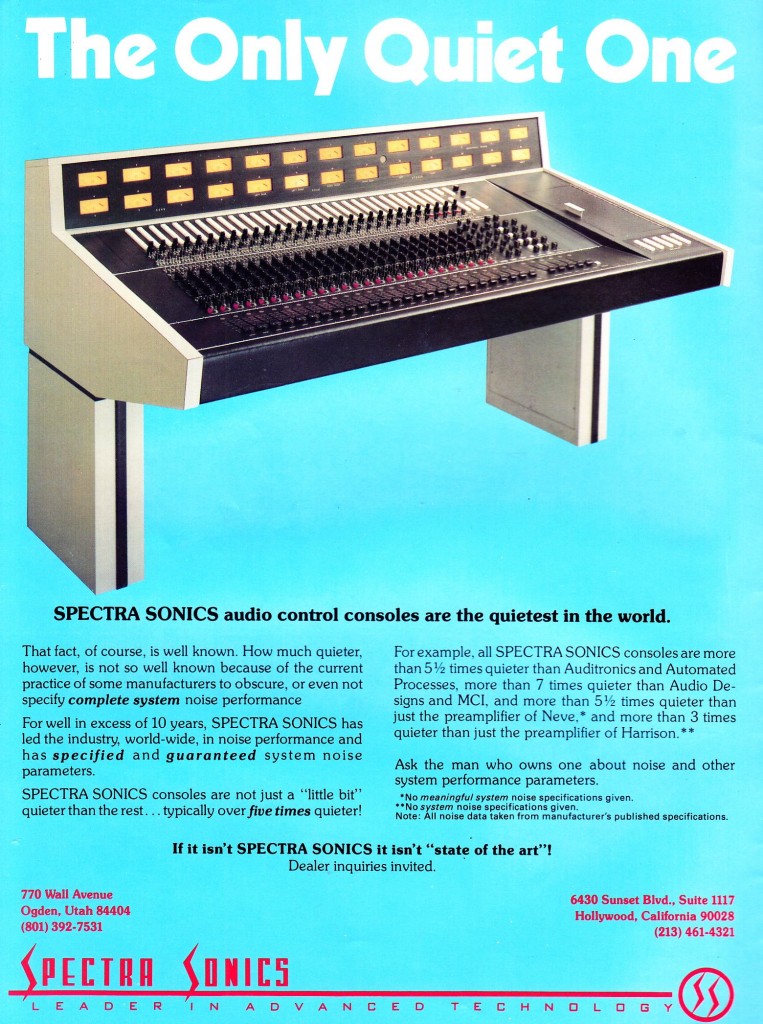 Above: Spectra Sonics console circa 1977.
Above: Spectra Sonics console circa 1977.
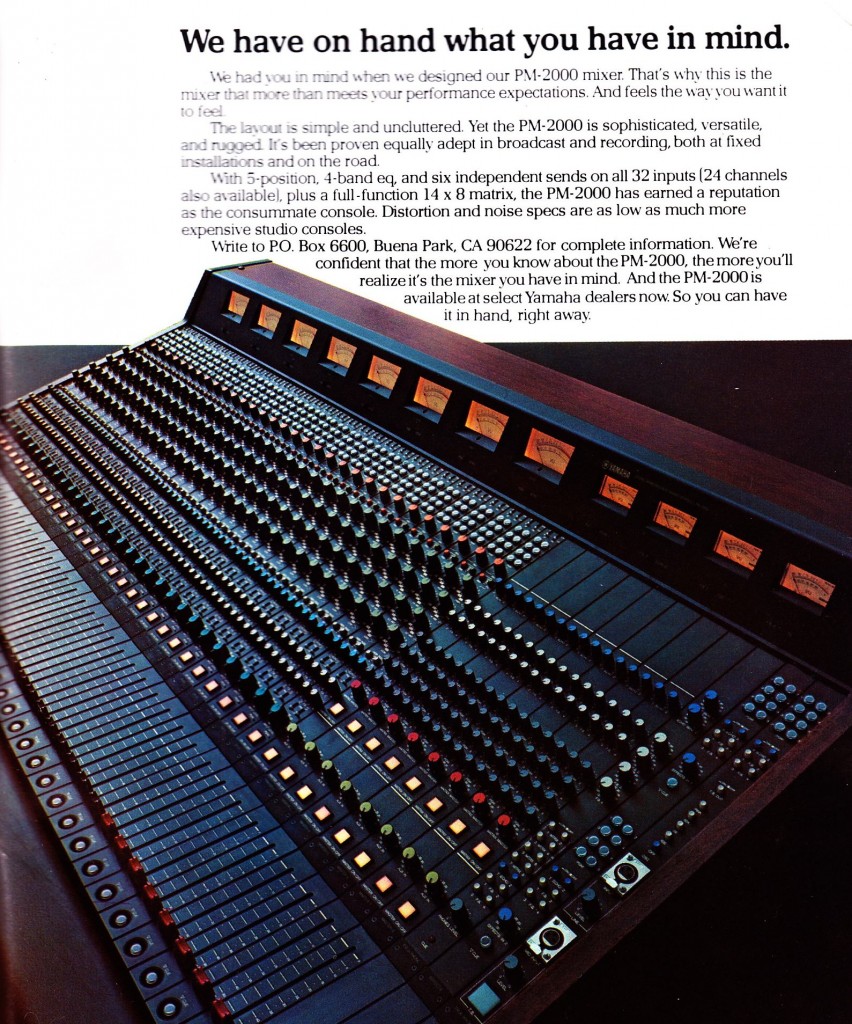 The Yamaha PM2000 of 1980, successor to the -“Japa-Neve” PM1000. And apparently even better? Weigh in…
The Yamaha PM2000 of 1980, successor to the -“Japa-Neve” PM1000. And apparently even better? Weigh in…
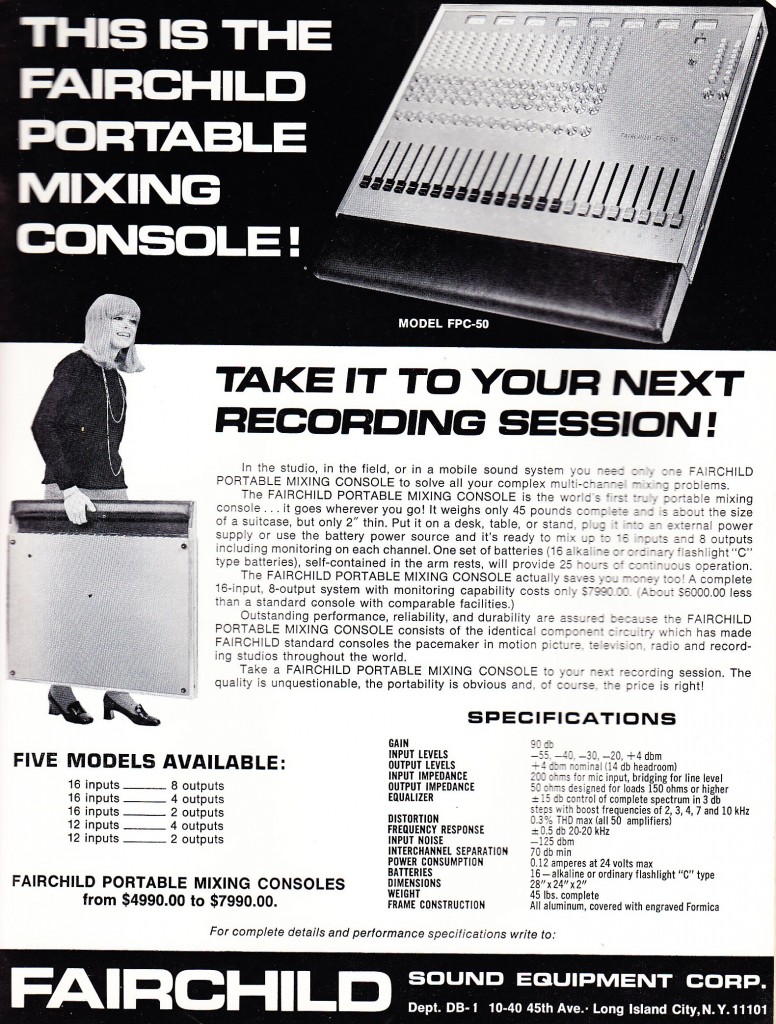 Here’s an unusual one: The Fairchild Portable Console of 1970, likely one their last pro-audio products. I have never seen one of these before. Anyone?
Here’s an unusual one: The Fairchild Portable Console of 1970, likely one their last pro-audio products. I have never seen one of these before. Anyone?
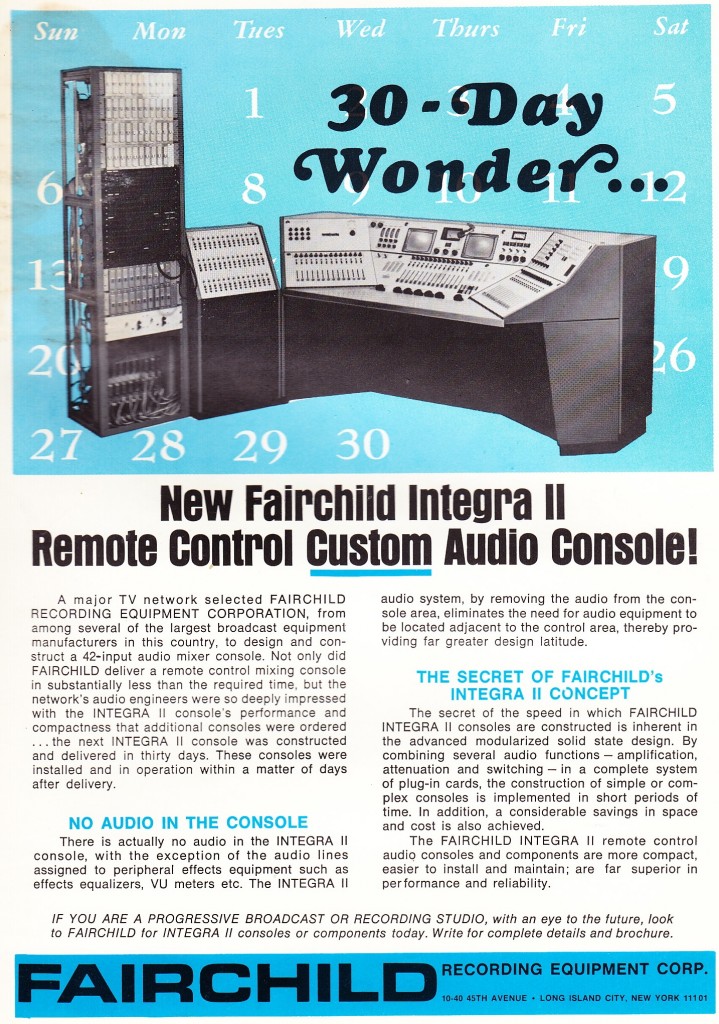 …and not quite the 70s, but… Fairchild introduces their INTEGRA console, 1968, with the bold notice “No Audio In The Console.” It’s pretty incredible how ahead of its time Fairchild was. Anyone ever use an INTEGRA? Did it sound good/work well? Bits and bobs from these monsters seem to surface on eBay all the time, but I doubt there is still a complete unit out there. Anyone?
…and not quite the 70s, but… Fairchild introduces their INTEGRA console, 1968, with the bold notice “No Audio In The Console.” It’s pretty incredible how ahead of its time Fairchild was. Anyone ever use an INTEGRA? Did it sound good/work well? Bits and bobs from these monsters seem to surface on eBay all the time, but I doubt there is still a complete unit out there. Anyone?
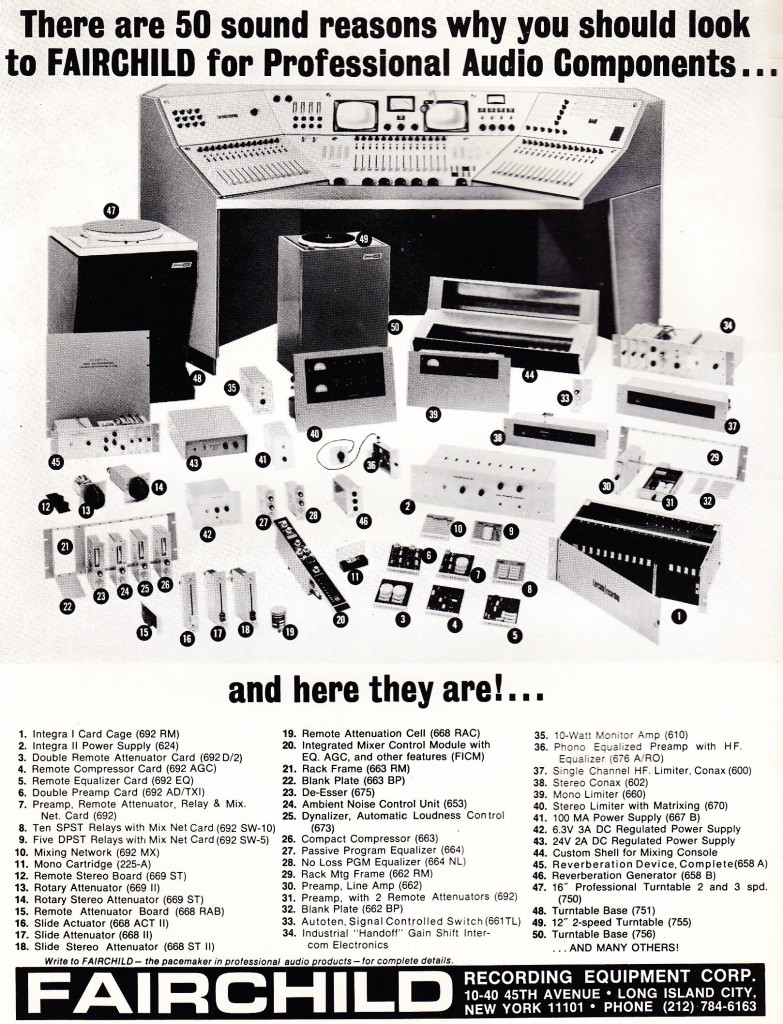 …and here’s a breakdown of all the aforementioned bits+bobs.
…and here’s a breakdown of all the aforementioned bits+bobs.
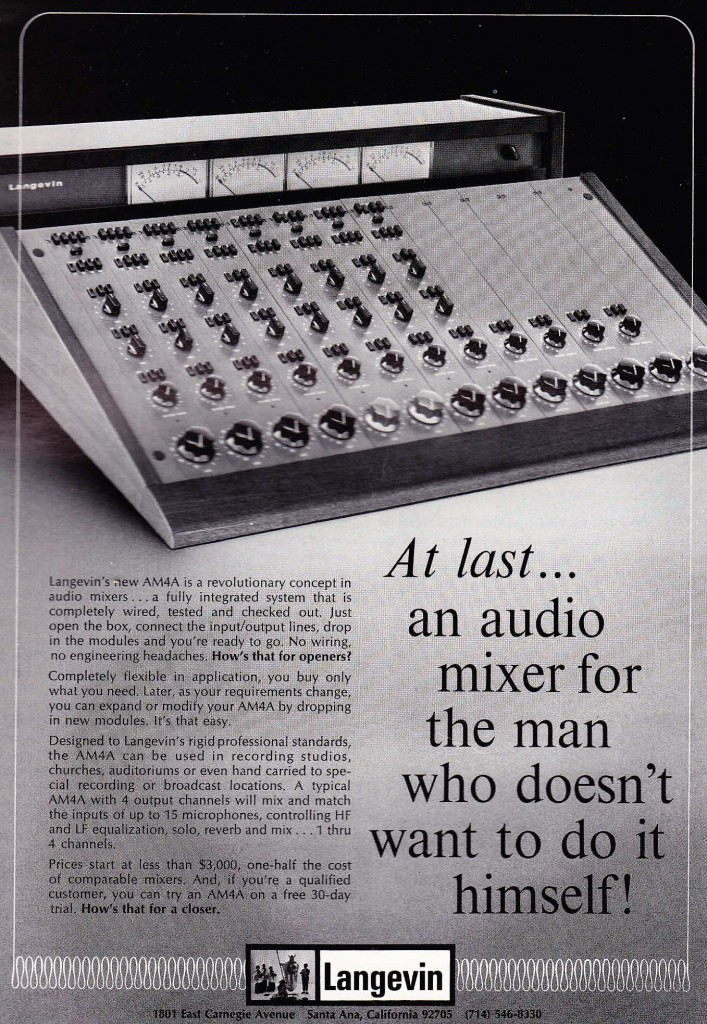 While all of the Fairchild Integras may have been carved up, the Langevin AM4A, certainly the opposite end of the technological spectrum, seems to have fared quite a bit better… I often see these on the market in the $10K range, and I have to admit I have often been tempted… Can any one tell us how these compare in terms of noise and response to a modern summing mixer? Anyone using these to mix thru?
While all of the Fairchild Integras may have been carved up, the Langevin AM4A, certainly the opposite end of the technological spectrum, seems to have fared quite a bit better… I often see these on the market in the $10K range, and I have to admit I have often been tempted… Can any one tell us how these compare in terms of noise and response to a modern summing mixer? Anyone using these to mix thru?
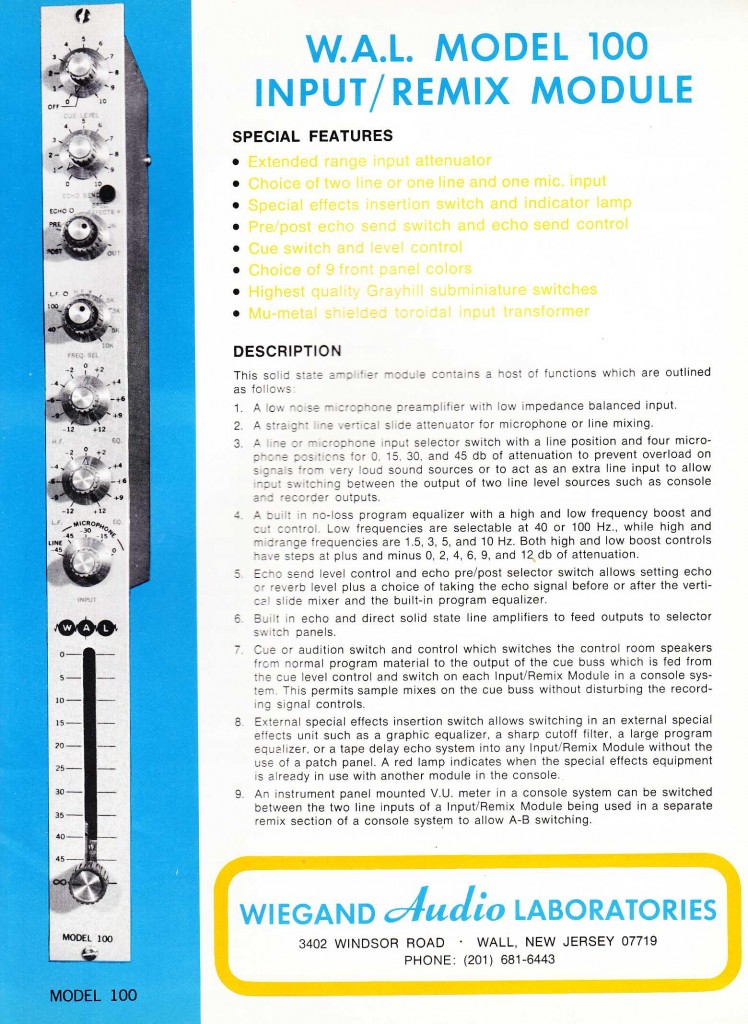 Wiegand Audio Labs offered their Model 100 channel strip in 1969
Wiegand Audio Labs offered their Model 100 channel strip in 1969
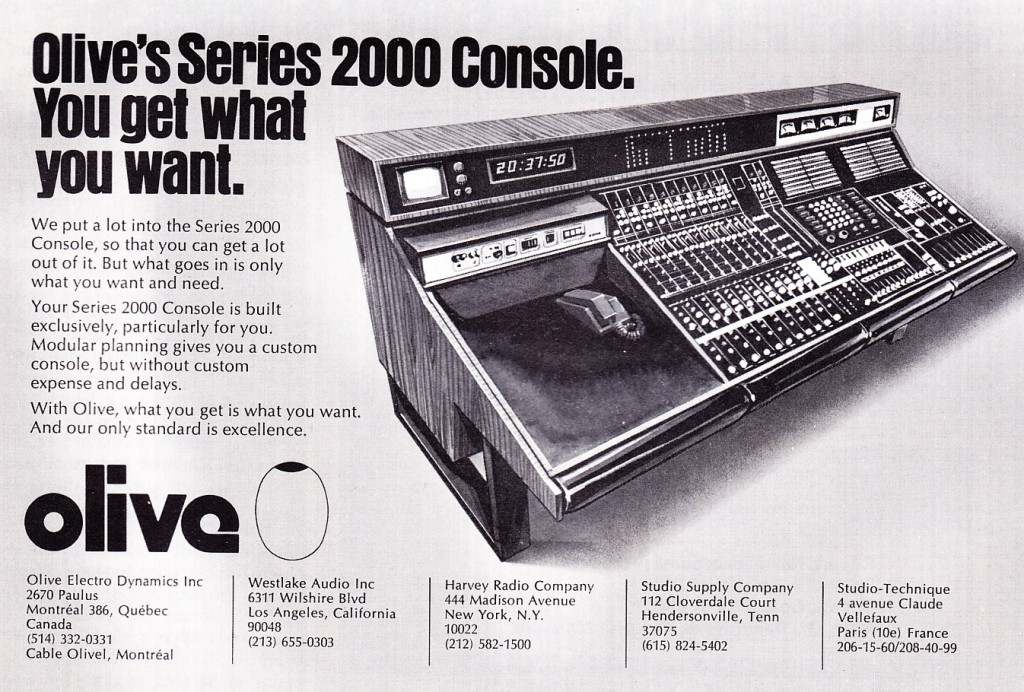 Montreal represent! I KNEW there had to be a Montreal maker of boards in the 70s… and sure enough, we find OLIVE. Here’s the Olive 2000 circa 1972. Seems lost-to-history… anyone?
Montreal represent! I KNEW there had to be a Montreal maker of boards in the 70s… and sure enough, we find OLIVE. Here’s the Olive 2000 circa 1972. Seems lost-to-history… anyone?
Much closer to Langevin than Fairchild, here we see the Altec 9300 circa 1970
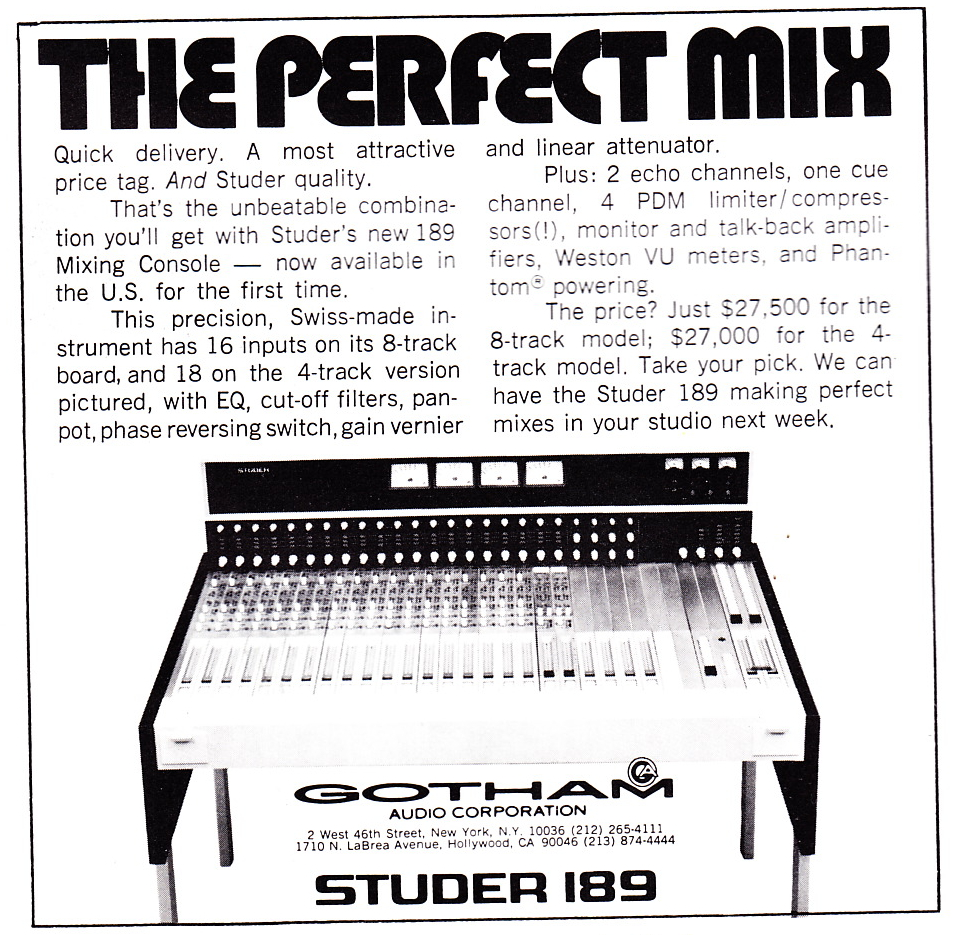 Above: Studer 189 circa 1972. Just $148,000 (no typo) 2013 dollars!
Above: Studer 189 circa 1972. Just $148,000 (no typo) 2013 dollars!
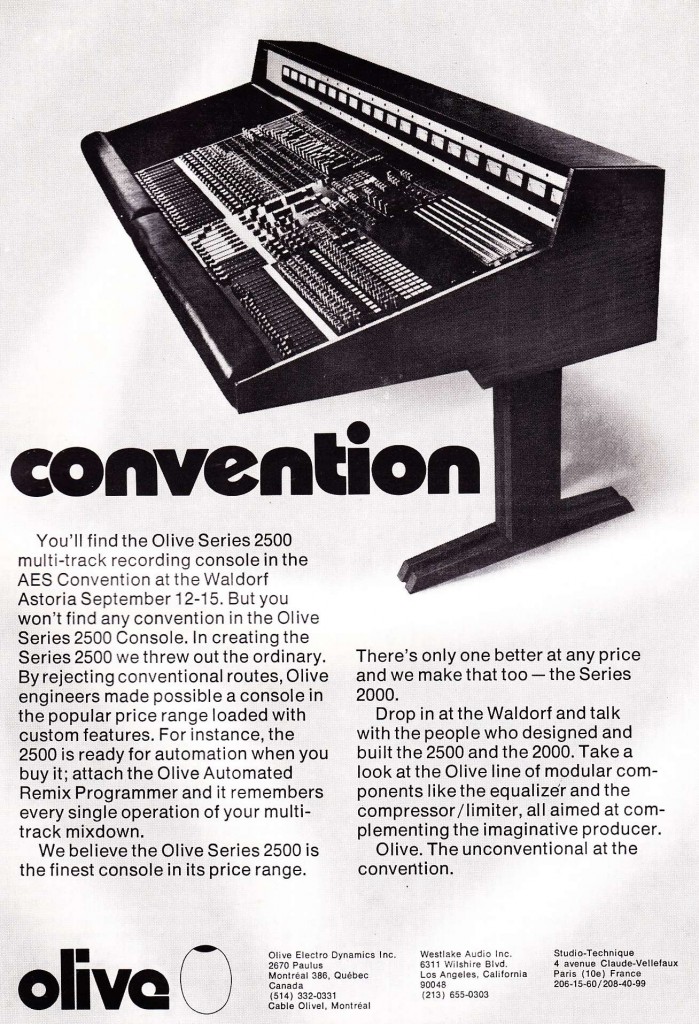 Olive also offered a 2500 model in 1972
Olive also offered a 2500 model in 1972
*************
*******
***
If any of y’all are actively using any of this stuff, write in and let the world know how they are in terms of sonics, reliability, and general utility. There is very, very little information online concerning some of these pieces, so you could end up being very helpful to some potential future user of these these machines…
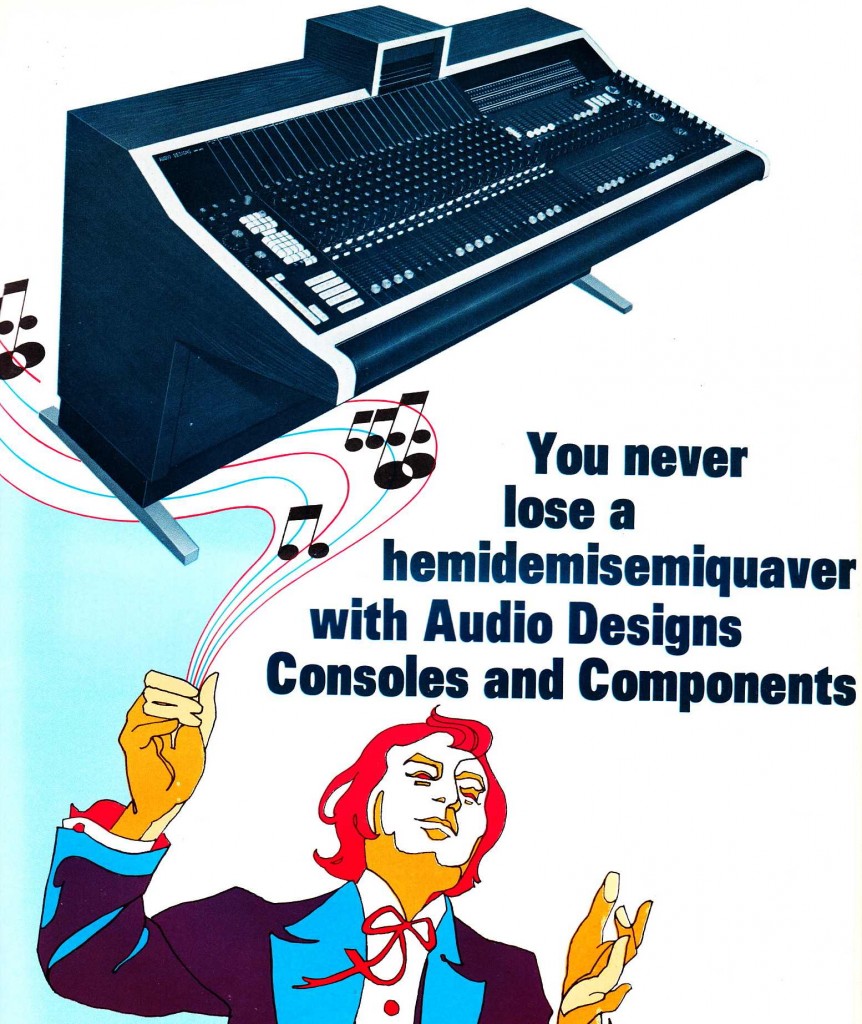
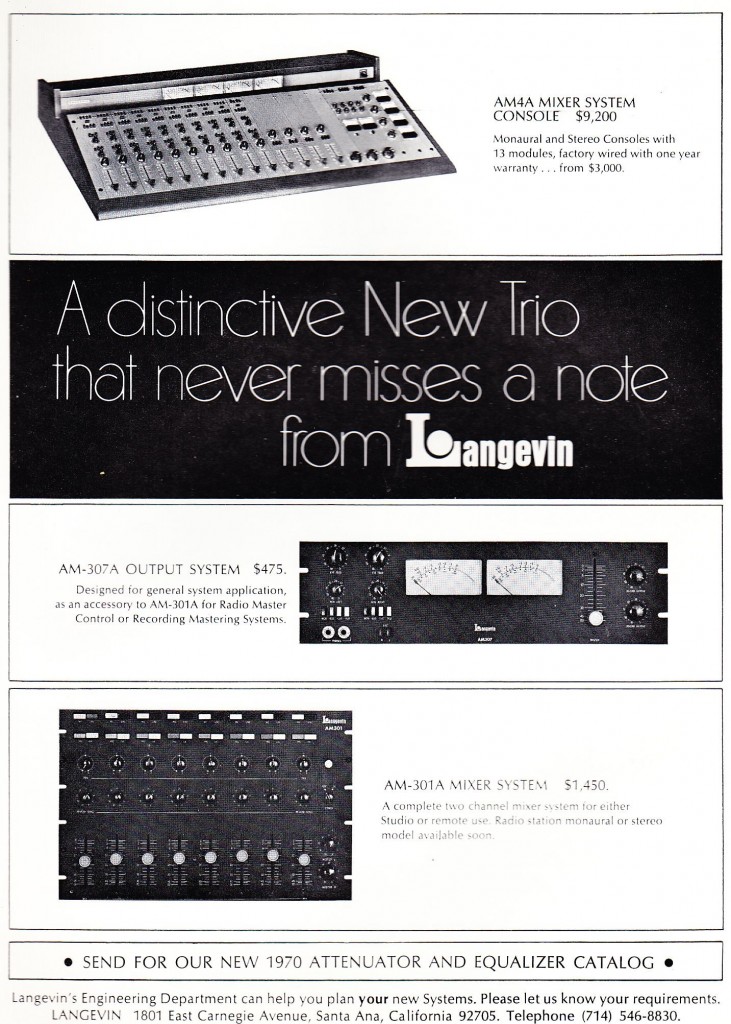
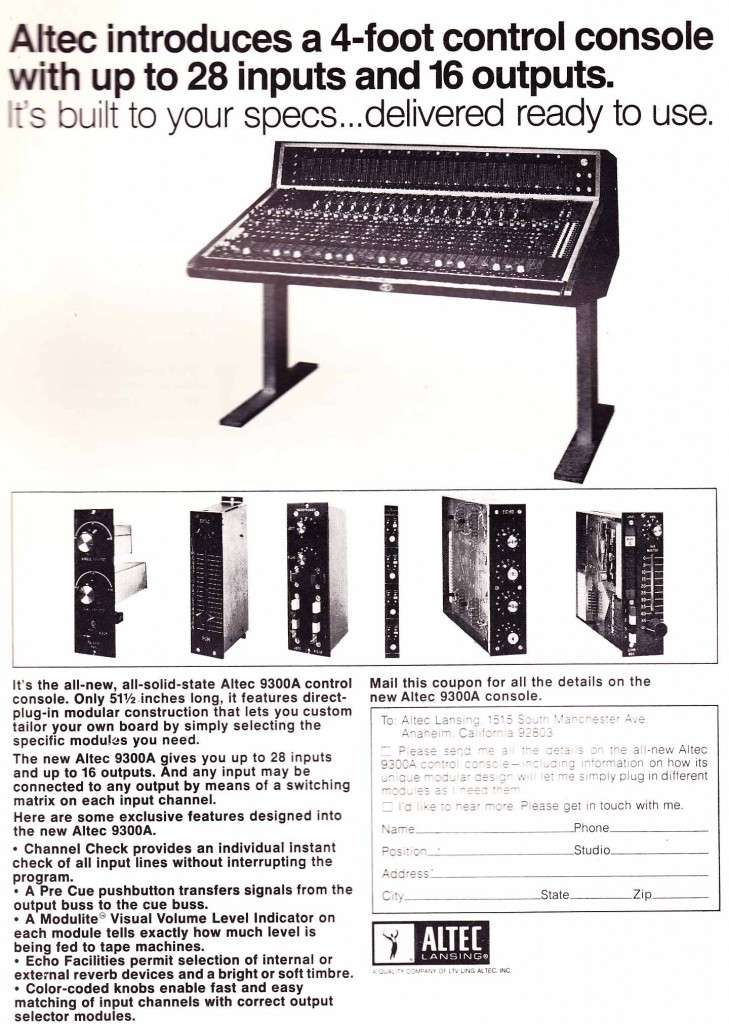
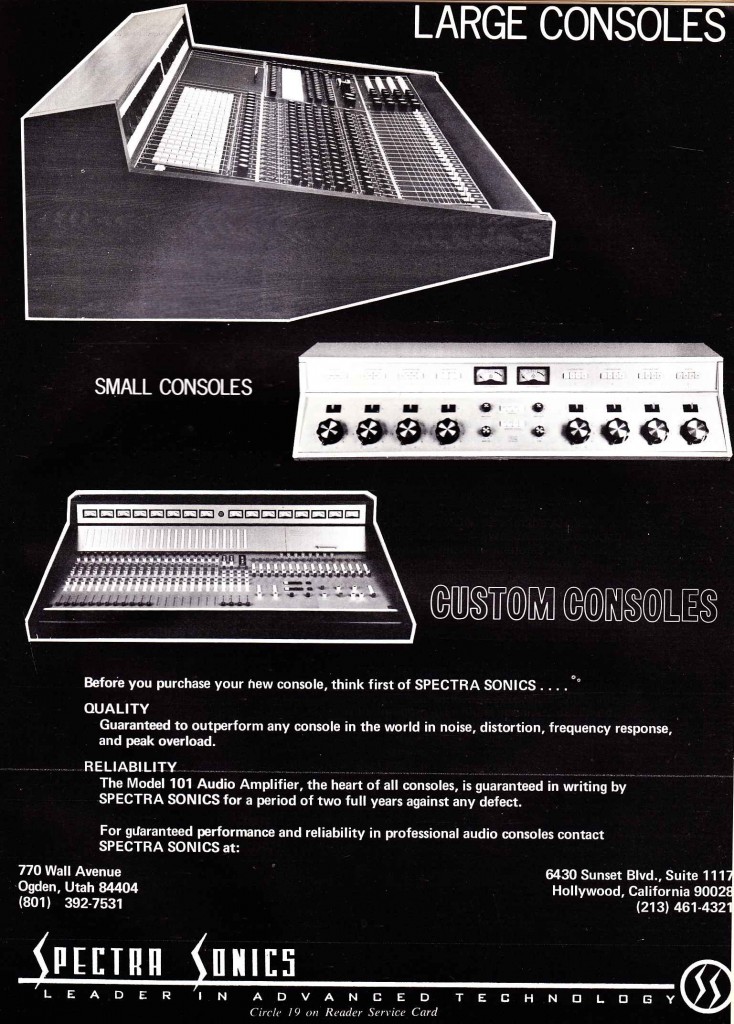
24 replies on “Consoles of the 70s : part 2”
Regarding Sphere, they seem to run in the same family as QuadEight and Electrodyne, according to TapeOp magazine. Apologies if you were aware of this already.
http://www.cinemag.biz/electrodyne/electrodyne_part_1.html
Wow, the benefits of google.. I was a fresh out of high school kid, with a junior college education, when I began working at Sphere. There were some smart people (in the midst of chaos), but with an bold idea for 1982. While Neve and SSL were trying to create (as far as I can remember) automated boards with motorized potentiometers, we were trying to create a fully optical system that tracked (via LED) the finger movements on the “sliders”. The biggest fear everyone and back then, was noise from the motors controlling the pots. The theory was that by going fully optical, we could eliminate any of that noise.
Great theory, huge engineering challenge. When I left in early 1983, it is my recollection that the few installations that they had were incredibly bug ridden, and knew that their theoridical system, was never going to bye a reality with their incredibly limited budget.
For a kid who loved music and electronics, I got to design the circuits, do all of the drafting, build and test what could have become the cutting edge in recording technology. But in the end, the internal issues sunk their ship, and I chose triathlons.
I’m particularly impressed by those Fairchild turntables….but new rubber parts would be needed. One model had a three phase tube oscillator for full variable speed!
So cool! I really enjoyed this blog, Ive never heard of sait or olive, and its seems like olive is canadian to boot. i used to use a few of these consoles here and there, particularly the audiotronics. I n0w want a fairchild turntable. i also own a Chilton, which could be on this list.
I hvae NEVER found anything but eyewitness reports about the British Console manufacturer Zoot Horn but Is love toknow more, I have one of their power supplies. so if you ever find anything out about that one….
Oh, man. This page is chock full of console inspirational material.
funky old designs. wow. Loving it.
I’m in the works of putting together a small format Auditronics 110 console.
Debating about whether to use full length faders, or rotary pot’s, and that Langevin AM4A is providing some definite points on the space-saving rotary pot side of the argument!
This site seems to have a good history of the OLIVE console. There were only two or three of these consoles that were put into service, (not sure why).
Caribou Ranch installed one, to be replaced later by a Neve . Andre Perry also had one, (church studio?), in Canada. There’s a Andre Perry web page with photos, and you can see it there.
http://www.historyofrecording.com/Olive_Console_and_Caribou_Ranch.html
http://www.andreperrystudios.com/biography/index.php?lang=en
great info greg, thanks for sharing! c.
Holy S%^& greg i just read that article… WOT A FKKN DEBACLE!!! is every industry filled with these sorta tales of idealistic entrepreneurs who get in way, way over their heads? wild man. dude had a dream tho, didn’t he…
Hi Greg and Chris:
That article about the Caribou Ranch is indeed very interesting. Like Chris said, what a debacle!
One nit to pick — the beginning of the article talks about pioneers of “channel strip” modular console parts, in the mid-60s. It neglected to mention Audio Designs and Manufacturing (ADM), and its founder Bob Bloom. Bob was a pioneer in this market. One of his first modular consoles was installed in Fine Recording Studio B, in late 1967. It was originally designed for 8-track (and included 8 monitor channels, which fed 8 speakers), and was later modified to accommodate the short-lived 12-track (Scully) 1″ format. Quad-Eight was a later entrant in this market. I do think the other companies mentioned were early payers.
— Tom Fine
Caribou Ranch’s Olive console was not so much a debacle as it was the forward thinking of owner Guercio to fulfill a need. That need was full creativity without distractions. While it was ahead of its time , it was put into the studio prematurely. More R&D and time to fully develop the protocols was needed for flawless operation. as far as the ranch itself destination recording studios were just coming into acceptance yet there were few. Caribou was one of the first with All Inclusive @ $16,000. a week for up to 15 persons : Engineer if needed ( tape xtra) , Studio instruments, Historic lodge and cabin accommodations, 24/7 meals, phone calls, Horses, vehicles to run into nearby Nederland or Boulder, various Pool tables, Foosball, Pinball games. Fresh air and elbow room .
do you have info on the Flickenger consoles?
nyet, comrade.
Keen to hear thoughts – pro’s / con’s on Yamaha PM2000 vs Auditronics consoles.
Debating whether to go for one or the other, or custom console using combination of Auditronics 110 and 501 channels, with custom mix buss etc etc (prob too much work!) vs no console, and just keep the routing a bit more direct / with digi control etc..
Flickinger went out of business as I recall and the head honcho got sent to prison for infringing on Spectra Sonic designs.
I won’t directly compare the PM2000 with a Neve 8078, because I’ve never heard them side by side. Without a true ABX comparison, it’s just opinion. So, I won’t take the bait 🙂
I will however state that the design, build, and sound of the PM2000 is astonishingly good. The only shortcomings are a relatively uninspiring but utilitarian EQ section and “swiss army knife” routing that does almost anything but specializes in nothing. And, they were Japanese, in the snobby, xenophobic market of the 1970s.
The construction and tolerances of these boards is absurd, with transformers everywhere, the high-headroom punchy 80200 mic pres, hand-wiring and trussing, and a (I think) cherrywood frame that looks like it was built in the piano factory. To build a 32 channel board to the level of build quality present in these boards would cost $150K+ in today’s markets, and a good quality survivor can be had for as little as $5K.
Snobbery is rampant in the vintage gear world, and no, the PM2000 is not an 8078 Neve. It might not even quite be an API 3208, whatever those cost these days.
What I can say for sure is that, at under $200/channel the PM2000 has to be the most ridiculous deal ever for a piece of true big-iron mixing history.
The ad for the Fairchild portable console caught my eye. We had one at Sonad Studios in Milwaukee in 1970. It was built into a larger console and was pulled out to do remotes. The board was lightweight and ran on 12 D cells that went in the armrest. The big problem on the remotes was moving the Scully 8 track. That was a beast.
I purchased one of the Audio Designs and Manufacturing consoles (ADR console) back in 1976 and, OMG, what a SOUND that thing had! All discrete, the first console with reed-relays used for buss & aux assignment, GREAT sounding EQ. I listen to mixes done on that thing 40-years later and they’re still big and fat!!
[…] Consoles of the 70s : part 2 | Preservation Sound. (2016). Preservationsound.com. Retrieved 18 August 2016, from https://www.preservationsound.com/?p=6130 […]
I used to own a 1″ Scully with the 280 electronics and it was not what I would call a “location” recording device, so I totally get the “beast” description. I replaced it with a Scully model 100 16-track which was even heavier. Also, as a guy that was trying to build a commercial studio on a budget, the Japanese boards’ performance was enticing even if it meant being ribbed about having a mixing desk that was made by a company that also produced transistor radios or other consumer electronics.
I worked as the technician at Thunder Sound for a while until the doors were locked.
The Olive console was hated by everyone that came into contact with it.
When it worked, it sounded quite good.
The studio was busy making albums and remixing disco.
The biggest ongoing problem with Olive was a persistent oscillation at about 16 to 18KHz. The level and frequency would change as faders were moved. It was a rare day that all channels could be used and it wasn’t predictable which ones would work and which combination of things would set off the oscillation.
Each channel strip was on a plug in frame and then, to add to the problems, each strip had a whole bunch of small plug in cards with specific functions. For example there was a card with line driver op amps, a card with a DBX vca, a power supply regulator card, and a few more types.
After a very thorough cleaning of every contact on the mainframe and every contact on the channel strips, the mixer improved, slightly…
It was still a constant battle swapping the function modules on channel strips to keep the mixer usable at all.
After much testing and hours with the ‘scope I found that the power regulator modules on the channel strips were breaking into oscillation! The early dual tracking regulator chips were not up to the task and were a poor design. Because everything in the mixer was controlled by vca, as faders were moved, current draw changed and these unstable regulators changed their frequency.
I started a project to replace all the capacitors on the regulator modules with tantalums and added additional bypass caps.
As the number of rebuilt and modified modules increased, the mixer became more and more stable and sounded better.
A further project was planned to use a totally redesigned home brew regulator module using a more modern, quieter, more stable chip but, alas, I showed up to work one day and the doors were padlocked with a notice on them.
Wish I could find that mixer today, or at least some parts from it.
A few more console/mixer brands;
Tangent
Canary
Malachi
Raindirk
Eela
Soundtracs
D&R
Focusrite
AMEK
Sudiomaster
Pandora Systems
Eltec
Gately Electronics
2025AD
Philip Drake Electronics
WalkerAV
Mavis
AudioDesign
Tascam
Neotek
Plus about 20 more that I can see in my minds eye but can’t recall the names of … yet!
BTW last I knew was the Olive from the Univ of Colorado was bought out of storage about 10 years, made operational and in a working studio in Franklin, TN. Also Dan Flickinger got crosswise with the law over illeagal substances, not appropriating another’s circuit designs. He was a pretty brilliant designer in his own right, just not adept at business.
This website is so great! Thanks for all the gathering you’ve done! One thing I noticed on this page is that the console marked as ADR actually looks like an ADM 770 series console. Coincidentally I’ve lately been thinking about the similarity in their names because I recently required a bit of equipment from both brands, haha. Anyway, keep up the great work. I’m currently piecing together what will hopefully be a very cool ADM console and I’ll share my impressions once everything is up and running 🙂 🙂
Robbie:
Precisely! That is an ADM NRC recording console – perhaps it is the one designed and manufactured for Fine Recording.
TomC
Audio Designs and Mfg./ADM Design Engineer
I worked at Studio Six in Montreal in the 1st half of the 1970s. In 1972 we field tested Olive Electrodynamics “automated” mixing system. 16 faders controlling VCAs. The levels and movements were encoded into one digital signal and recorded on a track of the multitrack. Played back faders did not move but all levels tracked. Then you could press an update button update and record the old levels/movements plus changes on a new track. Then you bounced back and forth with each update. Yes, this reduced our 16 tracks to 14 but then you could easily record stuff here and there on tracks and use the 2 extra faders muted most of the time to “extract” these bits onlto extra input channels. I did the first “automated” mix of an album with that system. I believe it was the first in the world but certainly the first in N.A. A year later, summer 1972, we installed the system in our Neve 8024 changing to DBX VCAs (best at the time). With a 24track recorder and 32 programmable faders it was quite usable. Best thing that Olive made! This was the first “automated” Neve board. Rupert and his wife came to see what we had done. We gave him the $5 tour 😉 and had supper. Very nice man. I think he probably looked at the clumsy update method and thought (hmm? moving faders).